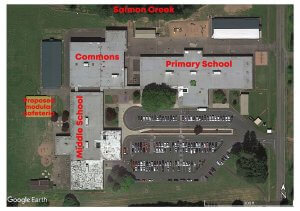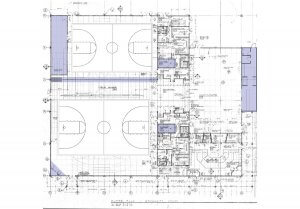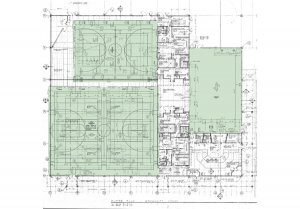PLEASANT VALLEY CAFETERIA PROPOSALS
Pleasant Valley Primary and Middle are the only schools in the district where students do not have access to a cafeteria. On this campus, students eat lunch in their classrooms.
In an effort to find a solution that would provide students a common space in which to eat, administrators and facilities personnel met with staff at Pleasant Valley and with parents during a PTO meeting to discuss options, answer questions, and get input.
The district explored several suggestions; and has brought forth for consideration three feasible options that would make lunchtime more equitable for the students at Pleasant Valley. The three options are: Installing a stand-alone modular cafeteria, converting the small gym to a (multipurpose) cafeteria, or increasing the serving capacity of the current kitchen space so that more students could be served lunch in less time. If one of these options is selected, the work would be done in the summer of 2021 in preparation for the 2021-2022 school year.
After reviewing the information on this page about lunchtime at Pleasant Valley schools and the three options, please provide input by taking our Pleasant Valley Lunch Options Survey.
Your feedback will help us do what’s best for students. Thank you for supporting Battle Ground schools!
Lunch at Pleasant Valley
Lunchtime at Pleasant Valley schools is different from every other school in the district. (Click the video, right, to see lunchtime at Pleasant Valley.)
The differences begin the moment that Pleasant Valley students arrive at the hot lunch counter in their main (primary or middle) building to purchase lunch.
Lunch counter
At the lunch counter, students must wait outside while 3 students at a time are allowed in the small space where they get their lunch tray and choose an entree. Some kitchen equipment does not fit in the kitchen and is moved outside the building during lunch service.
From the lunch counter, students walk into the hallway, where they select from a variety of fruits and vegetables presented on the a la carte cart on wheels. (This cart is rolled away for storage when lunch is over.)
The walk back to class
While balancing their trays, students must then return to their classrooms (some of them must walk outside to portable classrooms, regardless of the weather).
In their classroom, students eat lunch at their desks. Teachers also take their lunch break, and a supervisory support staff (basic education assistant) is assigned to every classroom for lunch supervision.
Allergies
Students who have life-threatening food allergies may be restricted from eating lunch in classrooms.
Clean up
After students finish eating, those who had hot lunch must carry their trays and leftovers outside to one of several food waste and tray return stations. Food waste stations attract stinging insects as there is no room for the stations inside the buildings.
Students then head to recess while the supervisory support staff clean each classroom, taking care to look for spilled milk and dropped food that could lead to carpet stains and attract pests.
Why the potential change?
There are multiple reasons why the school board is considering options for providing a cafeteria for students on the Pleasant Valley campus:
Equity: Pleasant Valley is the only campus in the district (two of 18 schools) that does not have a cafeteria, creating an inequitable situation for students who must walk farther to get a hot lunch, carrying hot food into sometimes cold or wet weather.
Cleanliness: Staff must put in additional care and time to ensure that classrooms are cleaned after lunch and that spills and food do not become permanent stains or attractants to pests. Maintaining buildings is important to preserving the community’s investment in schools.
Staffing: Pleasant Valley requires 30 percent more staff time (about 8.5 hours more per day) than other schools only during the middle of the day, making it difficult to hire and retain employees who are available to work for a couple of hours each day.
State requirements for K-8 lunches: After conducting a lunch audit at schools across the state, The Washington State Auditor’s Office determined that students are not getting adequate time, once seated, to eat. The research showed that students who have at least 20 minutes of seated lunch time are more likely to consume healthy foods, and that one of the biggest obstacles to this issue is lack of adequate facilities. Based on the audit, The Office of the Superintendent of Public Instruction is considering implementing requirements that students get 20 minutes of seated lunch time.
Options Under Consideration
Click the tabs to read about each option.
 Modular Cafeteria
Modular Cafeteria
This option would place a modular building on the campus that would be used as a cafeteria. The modular would be located west of the middle school.
You can download a PDF image showing the location of the proposed modular cafeteria, or click the image to the right to enlarge it.
Details
New 4,480 square foot modular with food service counter, kitchen equipment, and lunch seating
Costs
| Component | Cost estimate* | |
|---|---|---|
| New 4,480 sq. ft. modular | $1,250,000 | |
| Site work | $350,000 | |
| Electrical work | $120,000 | |
| Furniture | $60,000 | |
| Kitchen equipment | $100,000 | |
| Total | $1,880,000 | |
Considerations
- Highest cost of the options that provide a stand-alone cafeteria.
- The location of the modular is limited due to the campus’s proximity to Salmon Creek and the required buffer zone. The west-side location means that primary school students would have to walk farther and need more time to get to and from lunch.
- Middle and primary school would each have its own gymnasium space.
- Lunches would be served by grade level in the modular cafeteria between the hours of 10:30 a.m. and 1:30 p.m.
- The kitchen space would be large enough to make fresh food on site.
- Because students eat in a single location, cleaning is efficient and spills do not cause permanent stains. Tray cleaning and food waste receptacles would be kept inside the cafeteria, away from stinging insects.
- Breakfast service would be more efficient and not encroach on learning time. Not all students purchase breakfast, so only those who do would go to the cafeteria, compared to all students sharing a classroom whether they are eating breakfast or not.
- Students with food allergies can eat in the cafeteria with their peers, albeit at a table for students with allergies.
- Schools can staff more efficiently and see a cost savings when students eat lunch in a single location.
- Teachers would have access to their empty classroom during lunch.
Small Gym-Cafeteria Conversion
 This option would convert the small gymnasium on campus into a cafeteria that both middle and primary students would use for lunch. The large gymnasium (also called a field house) on campus would be made dividable into 1/3 and 2/3 sections with a sound reducing, foldable wall. Pleasant Valley could fold the wall and use the entire gym, or the wall could divide the gym into two sections for both primary and middle schools to use the space for simultaneous physical education classes.
This option would convert the small gymnasium on campus into a cafeteria that both middle and primary students would use for lunch. The large gymnasium (also called a field house) on campus would be made dividable into 1/3 and 2/3 sections with a sound reducing, foldable wall. Pleasant Valley could fold the wall and use the entire gym, or the wall could divide the gym into two sections for both primary and middle schools to use the space for simultaneous physical education classes.
You can download a PDF image of an architectural drawing showing the converted gym space with the addition of a kitchen and changes to bathroom and locker rooms, or click the image to the right to enlarge it.
Details
The small gymnasium would be converted to a cafeteria for use by both schools. A small modular would be installed adjacent to the small gym to house the kitchen and equipment. Students would eat in the cafeteria by grade level.
The large gym would be fitted with a sound reducing, foldable wall that could be folded (open) for all-school functions or closed for simultaneous use by multiple physical education classes.
Existing bathrooms and locker rooms would be revised and remodeled so that primary and middle school students would have separate bathroom facilities.
Costs
| Component | Cost estimate* | |
|---|---|---|
| 840 sq. ft. kitchen modular next to gymnasium | $495,000 | |
| Site work | $80,000 | |
| Electrical work | $30,000 | |
| Furniture | $60,000 | |
| Kitchen equipment | $100,000 | |
| Sound reducing, folding wall | $175,000 | |
| Structural upgrades for folding wall | $60,000 | |
| Bathroom and locker room revision and renovations | $100,000 | |
| Total | $1,100,000 | |
Considerations
 Lowest cost of the options that provide a stand-alone cafeteria.
Lowest cost of the options that provide a stand-alone cafeteria.- Pleasant Valley has two gyms: a large gym and a small gym. The large gym at Pleasant Valley is 15,000 square feet, and most gyms in the district are 8,000 square feet. If converted, the small gym/cafeteria and large gym would still provide the same amount of gymnasium and cafeteria space as the district’s newest shared campuses: Daybreak and Tukes Valley. Download a PDF image showing the Tukes/Daybreak gyms and cafeteria overlaid on a plan of the Pleasant Valley gyms using the same scale for each building, or click the image to the right to enlarge.
- Converting the small gymnasium to a cafeteria means that students at both the primary and middle would use the large gym for physical education classes while lunches are served in the small gym/cafeteria.
- The large gym would be divided by a sound reducing, foldable wall for the purpose of sharing. Primary and middle school students would have their own space for physical education classes, as well as separate restrooms. The wall could be folded for use of the entire space.
- Lunches would be served by grade level in the small gym/cafeteria between the hours of 10:30 a.m. and 1:30 p.m.
- The kitchen space would be large enough to make fresh food on site.
- Because students eat in a single location, cleaning is efficient and spills do not cause permanent stains. Tray cleaning and food waste receptacles would be kept inside the cafeteria, away from stinging insects.
- Breakfast service would be more efficient and not encroach on learning time. Not all students purchase breakfast, so only those who do would go to the cafeteria, compared to all students sharing a classroom whether they are eating breakfast or not.
- Students with food allergies can eat in the cafeteria with their peers, albeit at a table for students with allergies.
- Schools can staff more efficiently and see a cost savings when students eat lunch in a single location.
- Teachers would have access to their empty classroom during lunch.
Increase Serving Capacity; Eat in Classrooms
This option would modify the lunch service areas at both Pleasant Valley Middle and Primary schools so that more students could get their lunch in less time. Students would still eat lunch in their classrooms.
Costs
| Component | Cost estimate* | |
|---|---|---|
| Renovation to middle school food service area | $50,000 | |
| Renovation to primary school food service area | $50,000 | |
| Kitchen equipment at both primary and middle schools | $60,000 | |
| Total | $160,000 | |
Considerations
- Lowest cost of all the options.
- Middle and primary school each has its own gymnasium space.
- Students continue eating lunch and breakfast in their classrooms:
- Requires more staff than stand-alone cafeteria
- Requires more intensive cleaning than stand-alone cafeteria
- Students at greater risk for insect stings when cleaning trays
- Would require additional lunch service staff at each school to expedite lunch service.
- As is current practice, the small kitchen space of this option would require the school to rely on the district’s central kitchen for food preparation.
- Students who have life-threatening food allergies may be restricted from eating lunch in classrooms.
- The modifications might require renovation to the existing adjacent space at the schools.
- As is the current practice, teachers would not have access to their empty classrooms during lunch.
FAQ
The district has asked the community in three separate elections to pass a bond that would have replaced Pleasant Valley schools, along with other projects; however, the bond has not passed. Each time, the bond received a majority (50%) of the votes, but failed to get the 60 percent supermajority required to pass.
The board has discussed the possibility of running a smaller bond, but not until the district’s current bond is paid off in 2023. No decisions have been made about what projects would be included on that bond. The oldest primary and middle buildings in the district are Glenwood Heights Primary and Laurin Middle School.
No. The district cannot use impact fees to expand or add to core facilities at an existing school or make school improvements. Impact fees can be used to provide additional classrooms to accommodate growth.
 Pleasant Valley has two gyms: a large gym and a small gym. The large gym at Pleasant Valley is 15,000 square feet, and most gyms in the district are 8,000 square feet. If converted, Pleasant Valley’s small gym/cafeteria and large gym would still provide the same amount of gymnasium and cafeteria space as the district’s newest shared campuses: Daybreak and Tukes Valley. Click the image to the right to enlarge a drawing that shows the Daybreak/Tukes Valley gym and cafeteria overlaid on a floor plan of the Pleasant Valley gyms.
Pleasant Valley has two gyms: a large gym and a small gym. The large gym at Pleasant Valley is 15,000 square feet, and most gyms in the district are 8,000 square feet. If converted, Pleasant Valley’s small gym/cafeteria and large gym would still provide the same amount of gymnasium and cafeteria space as the district’s newest shared campuses: Daybreak and Tukes Valley. Click the image to the right to enlarge a drawing that shows the Daybreak/Tukes Valley gym and cafeteria overlaid on a floor plan of the Pleasant Valley gyms.
Yes, the district’s newest primary and middle schools, Daybreak and Tukes Valley, share a commons area that has a gymnasium, cafeteria/gym/stage, and a library.
The current PVP small gym is approximately 3,960 square feet. The proposed PVP gym space is approximately 4,950 square feet.
Funding to replace the gymnasium floors at Pleasant Valley is not included in the estimated costs for the three lunch options.
Replacing the large gymnasium floor is on the list of maintenance projects that the district plans to complete over the next three years with levy funds, regardless of which lunch option is selected.
If the gym conversion option is selected, the work will include revisions and remodeling of the bathrooms in the large gym so that primary and middle school students will have separate bathroom facilities.
If the option selected impacts the rock climbing wall, it could be moved. If the option impacts the large gym track, it could be reconfigured.










 11104 N.E. 149th Street,
11104 N.E. 149th Street,